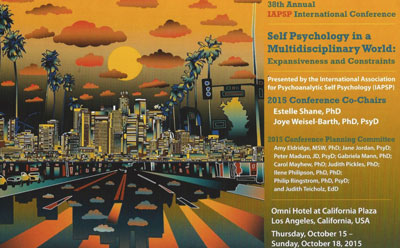By Daniel Goldin (USA)
Some conferences are memorable for a few particular presentations. Others envelop and linger in memory. The relational conference in Toronto this past June was certainly one of the lingerers.  To be there was to be part of a movement at the peak of its vitality, pulling closer to its psychoanalytic roots as it explored new spaces. This year’s 38th International Association for Psychoanalytic Self Psychology (IAPSP) conference in Los Angeles featured some of the same faces, but it lingered in a different way. Taking place from October 15-17, this conference was organized by Estelle Shane and Joye Weisel-Barth. True to its multidisciplinary theme, the conference stretched self psychology almost to its breaking point in its insistent view of Kohut’s paradigm as a living, evolving movement influenced by and influencing the world we live in now.
To be there was to be part of a movement at the peak of its vitality, pulling closer to its psychoanalytic roots as it explored new spaces. This year’s 38th International Association for Psychoanalytic Self Psychology (IAPSP) conference in Los Angeles featured some of the same faces, but it lingered in a different way. Taking place from October 15-17, this conference was organized by Estelle Shane and Joye Weisel-Barth. True to its multidisciplinary theme, the conference stretched self psychology almost to its breaking point in its insistent view of Kohut’s paradigm as a living, evolving movement influenced by and influencing the world we live in now.
Robert Stolorow opened the conference with a moving address on emotional trauma that was felt to be both a culmination of his life’s work and an immediate reaching out to his audience. He urged us to “undergo the situation” with our patients and lean into their worlds in a more active, engaged way. He described cultivating an attitude of “emotional dwelling,” an expansion of Kohut’s notion of empathic immersion that encourages rather than denies our analogizing participation in our patients’ experience. I think all of us were leaning in as he spoke, as much toward the man as toward his ideas.
Following the keynote address, the conference offered six plenary panels and 23 paper presentations. The paper presentations covered issues ranging from how self psychology can take on issues of racial and religious difference and avow, rather than disavow, the current climate crisis as central to our collective psyche. There were also meditations on cultivating a dynamic systems sensibility and a somewhat separate emphasis on a supra-scientific, hermeneutic turn in self psychology, a turn that meets up with other relational theories.
The plenary panels all seemed to have big things to say. Phil Ringstrom and Steven Knoblauch argued for focusing on, if not cultivating, improvisation and spontaneous composing in the clinical encounter, a riding with the experiential instant that keeps alive a vital, enactive aspect of the relationship. Ilene Philipson and Roger Frie, in a point-counterpoint format, considered how Kohut’s refusal to acknowledge his status as a Jewish holocaust refugee might have blinded him to cultural influences in the clinical situation, in particular to extra-familial trauma. Barbara Pizer and Lucyann Carlton asked the forbidden question, “Can we be lovers?” and considered how an affirmative answer in a particular psychoanalysis reverberated painfully through a life. Joye Weisel-Barth, Daniel Goldin, and Terry Marks-Tarlow explored how storytelling in words and pictures constitutes both the subject and the instrument of psychoanalytic understanding. Judith Pickles and Judith Rustin took us on a mindful journey through the body and the brain, lest we forget that our words and our thoughts need to get “fleshed out.” Peter Maduro and Bill Coburn brought in moving autobiographical and clinical accounts to consider the commensurability of seemingly discrete forms of human knowledge, and Donna Orange closed the conference with a moving plea to consider the fate of our planet in our daily actions. “We speak of it all being grist for the mill,” she said. “But what happens when there is no mill?”
After each panel, the conference broke up into small discussion groups run by leaders in the field, these cohorts remaining together throughout three days of talks. This was one of the most successful innovations of the conference. The usual chatter following panels took an ever-evolving coherence in these group dialogues, and we made some friends too. This sense of continuing, collegial meditation was true of the conference as a whole. It kept going after it was after.
 Daniel Goldin, MFT
Daniel Goldin, MFT
1515 Hope St., Ste. 202
South Pasadena, CA 91030 USA
Email Daniel Goldin
website: http://www.danielgoldinpractice.com

